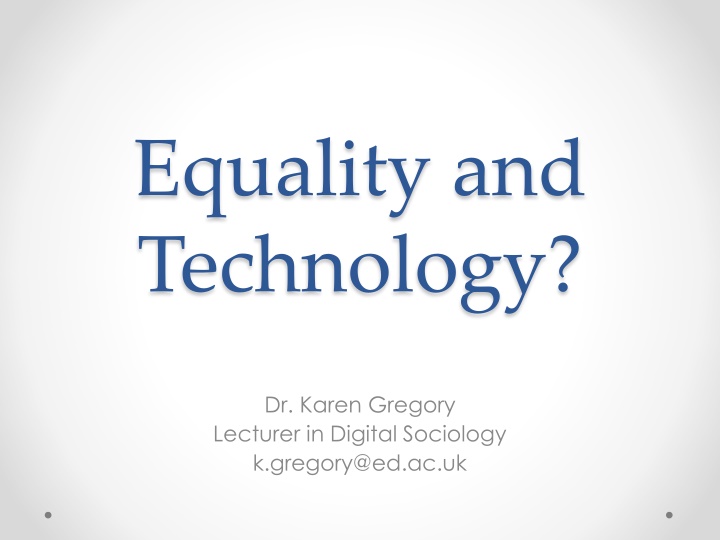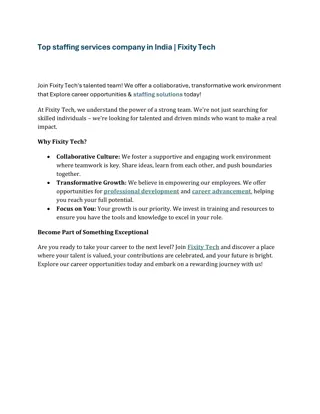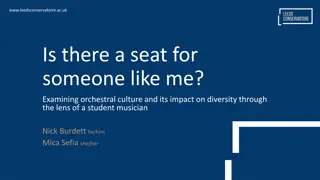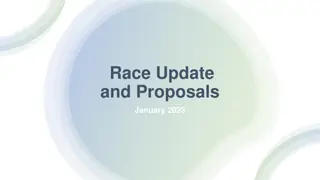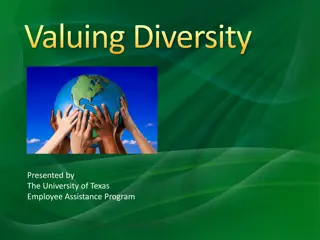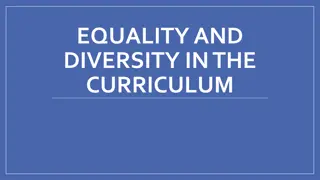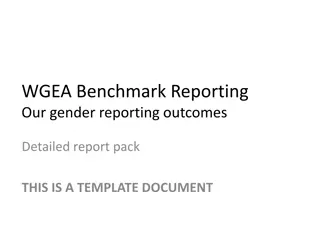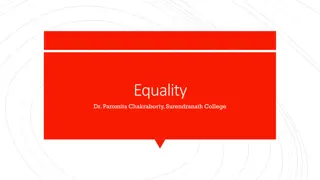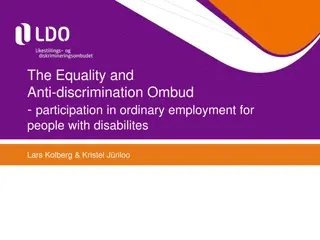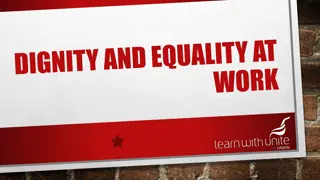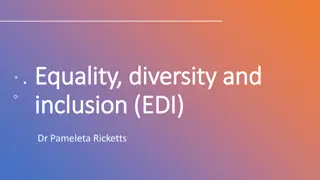Equality and Technology: Examining Tech's Impact on Diversity
This content delves into the intersection of technology and equality, exploring the implications of diversity within the digital world. It discusses the challenges, initiatives, and societal reflections of technological advancements on social structures, emphasizing the importance of inclusivity and addressing discriminatory systems in tech.
Download Presentation

Please find below an Image/Link to download the presentation.
The content on the website is provided AS IS for your information and personal use only. It may not be sold, licensed, or shared on other websites without obtaining consent from the author.If you encounter any issues during the download, it is possible that the publisher has removed the file from their server.
You are allowed to download the files provided on this website for personal or commercial use, subject to the condition that they are used lawfully. All files are the property of their respective owners.
The content on the website is provided AS IS for your information and personal use only. It may not be sold, licensed, or shared on other websites without obtaining consent from the author.
E N D
Presentation Transcript
Equality and Technology? Dr. Karen Gregory Lecturer in Digital Sociology k.gregory@ed.ac.uk
The Promise of Tech What type of digital world are we building? Why? How do technological developments mirror social values or social structures? Who does technology work for? Why? What is the relationship between education and the world we design and develop?
Coding crisis? Mastenbrook is CTO of AirStash, IoT Platform
Although the proportion of managers at U.S. commercial banks who were Hispanic rose from 4.7% in 2003 to 5.7% in 2014, white women s representation dropped from 39% to 35%, and black men s from 2.5% to 2.3%. Among all U.S. companies with 100 or more employees, the proportion of black men in management increased just slightly from 3% to 3.3% from 1985 to 2014. White women saw bigger gains from 1985 to 2000 rising from 22% to 29% of managers but their numbers haven t budged since then. Even in Silicon Valley, where many leaders tout the need to increase diversity for both business and social justice reasons, bread-and-butter tech jobs remain dominated by white men. Source: Quotes taken from Harvard Business Review. 2016. Why Diversity Programs Fail.
So What? Why does this matter? o Job demand. Estimated 1.4 million tech jobs by 2020. (29% US; of that 29% only 3% will be women) o The research shows that mixed-gender teams are more innovative, more creative and more productive. o Companies with a diverse group of employees make more money. o Companies with women in leadership positions have higher profits, higher sales and higher rates of revenue growth. You are not your user. Can one social demographic design for a complex world? More broadly, what is the relationship between discrimination in tech and discriminatory systems? (Source: Women Technologists Count: Recommendations and Best Practices to Retain Women in Computing. Anita Borg Institute, 2013)
Beyond Diversity? Response to this phenomena has been diversity training and diversity initiatives , but recent research suggests: o The positive effects of diversity training rarely last beyond a day or two, and a number of studies suggest that it can activate bias or spark a backlash. o Managers and employees react negatively to mandatory trainings. Voluntary training has marginally better success rates. o Diversity testing has resulted in cherry picking results, which amplifies bias. o Performance ratings and ranking have also been found to amplify bias. o Data driven, control solutions may compound existing inequalities and interpersonal bias. (Source: Harvard Business Review. 2016. Why Diversity Programs Fail. )
Gains for whom? Solutions must go deeper and speak to culture, social relations, and labor practices. Making room for more than different bodies, but complexity of experience and understanding of the world.
Some Definitions Prejudice: A positive or negative cultural attitude. Bias: Implicit or Explicit? Gender bias & racial bias. Stereotypes: associations, and attributions of specific characteristics to a group Racism, Sexism, Classism: Ideology, or a system of ideas. Discrimination: bias behavior or action taken toward Intersectional understanding: Double Jeopardy Source: Dovidio, et al. 2010. Prejudice, Stereotyping and Discrimination: Theoretical and Empirical Overview in The Sage Handbook of Prejudice, Stereotyping and Discrimination. London: Sage.
Implicit Bias Unconscious bias. Unintentional or human condition ? Design interventions, such as in Orchestra experiment. There is a tendency in implicit bias work to want to outsource judgment. Can data be less biased than the human who produce or analyze the data?
Psychology & Sociology But, is there a better way to understanding inequality and how it is socially reproduced? To that end, I thought we would look at the technology industry as a pipeline. And take a look at the sociological picture at each stage.
TheDigitalDivide & Education The demographic factors most correlated with home broadband adoption continue to be educational attainment, age, and household income. 74% of white adults have broadband Internet at home while 64% of African American and 53% of Latino adults do. 89% of those with a college degree have broadband at home; 57% of high school graduates and 37% of those without a high school diploma do. 88% of those who earn more than $75,000 have broadband at home; just 54% of those who earn less than $30,000 a year do. (Source: Pew Research, Home Broadband , 2013)
Higher Education & Gender Source: U.S. Department of Education, National Center for Education Statistics, Higher Education General Information Survey (HEGIS), "Degrees and Other Formal Awards Conferred" surveys, 1970- 71 through 1985-86; Integrated Postsecondary Education Data System (IPEDS), "Completions Survey" (IPEDS-C:87-99); and IPEDS Fall 2000 through Fall 2011, Completions component. (This table was prepared July 2012.)
The central conclusion is that the first personal computers were essentially early gaming systems that firmly catered to males. While early word processing tools were also available, the marketing narrative told the story of a new device that met the needs of men. As more males began purchasing computers for personal use, the nerdy programmer classification began to take hold in the professional world of computer science. By the mid-nineties, the percentage of women studying computer science at the postsecondary level had fallen to 28%.
Poor preparation and lack of encouragement in STEM subjects in school also contributes to a lack of women in STEM fields. The classroom climate for girls in school classrooms and for women students and faculty in university departments has been classically described as chilly (Hall & Sandler 1982). A dearth of role models: Women students look to faculty as role models for balancing career and family, and if career demands are seen as excessive, may leave their department in higher numbers than men (Ferreira 2003). Lack of critical mass of women in a department may lead to dissatisfaction and greater attrition of women scientists (Dresselhaus et al. 1995; Ferreira 2003). Salary gap and work-life balance issues already deter women in college.
Hiring Practices Over the past few years, we have been working hard to increase diversity at Facebook through a variety of internal and external programs and partnerships. We still have a long way to go, but as we continue to strive for greater change, we are encouraged by positive hiring trends. For example, while our current representation in senior leadership is 3% Black, 3% Hispanic and 27% women, of new senior leadership hires at Facebook in the US over the last 12 months, 9% are Black, 5% are Hispanic and 29% are women. Maxine Williams, Director of Global Diversity, Facebook
Workplace Practices If women find themselves in workplaces where colleagues or bosses assume they're less competent than men. Typically they work longer hours than their male colleagues, and cut back outside-work activities, which may lead to burnout. Women are likelier than men to suffer from imposter syndrome. Tech culture is hostile or even harassing. It may be harder for women to attend industry events than it is for men, because of personal obligations. There aren't very many female mentors, sponsors or role models. Women are impeded from forming strong professional networks to the extent those networks ordinarily form around gendered pursuits such as sports, or activities that may be risky for a lone woman among men such as getting drunk. These quotes are taken from Why Women Leave Tech compiled by Sue Gardner: https://docs.google.com/document/d/1soIYek-YEIvqtu9brv3ecdPbuVzQKp_GhAozC06UrLo/edit#
Career Trajectory Career Plateau and lack of advancement. Women leave tech in mid-30s, when men s careers begin to develop. Not only work-life balance or family as they leave for other jobs outside of tech industry. (source: The Athena Factor: Reversing the Brain Drain in Science, Engineering, and Technology, 2008)
Social Effects: From Apps to Social Systems SketchFactor: An app to allow users to report having seen or experienced something sketchy in a particular location; these reports would then be geotagged and overlaid on a Google map, creating a sketchiness heat map of a neighborhood or city. Marantz, A. 2015. When An App is Called Racist. The New Yorker: http://www.newyorker.com/business/currency/what-to-do-when-your-app-is- racist
Noble, S. 2013. Google Search: Hyper-visibility as a Means of Rendering Black Women and Girls Invisible. InVisible Culture: An Electronic Journal for Visual Culture. http://ivc.lib.rochester.edu/google- search-hyper-visibility-as-a-means-of-rendering- black-women-and-girls-invisible/
Try searching for professor in Google: https://www.google.co.uk/search?q=professor&safe= strict&espv=2&biw=1440&bih=721&source=lnms&tbm= isch&sa=X&ved=0ahUKEwjsiMDUx4zQAhWJCcAKHU3B AGUQ_AUIBigB
Bivens, R. and Haimson, O. 2016. Baking Gender Into Social Media Design: How Platforms Shape Categories for Users and Advertisers. Social Media + Society. October-December: 1 12. http://sms.sagepub.com.ezproxy.is.ed.ac.uk/conte nt/2/4/2056305116672486.full.pdf+html
Zukin, S., Lindeman, S. and Hurson, L. 2015. The Omnivore s Neighborhood: Online restaurant reviews, race, and gentrification. Journal of Consumer Culture. The study suggests that Yelp reviews not only reflect the impacts and public perception of gentrification, but ultimately help to determine who occupies a neighborhood as well. Indeed, the study concludes that, intentionally or not, Yelp restaurant reviewers may encourage, confirm, or even accelerate processes of gentrification by signaling that a locality is good for people who share their tastes. Beyond persuading potential customers to visit a restaurant, social media may in fact be part of the process of actually transforming neighborhoods.
Angwin, J. and Parris, T. 2016. Facebook Lets Advertisers Exclude Users by Race: Facebook s system allows advertisers to exclude black, Hispanic, and other ethnic affinities from seeing ads. ProPublica: Journalism in the Public Interest. https://www.propublica.org/article/facebook-lets- advertisers-exclude-users-by-race
In an experiment on Airbnb, we find that applications from guests with distinctively African-American names are 16% less likely to be accepted relative to identical guests with distinctively White names. Discrimination occurs among landlords of all sizes, including small landlords sharing the property and larger landlords with multiple properties. It is most pronounced among hosts who have never had an African-American guest, suggesting only a subset of hosts discriminate. While rental markets have achieved significant reductions in discrimination in recent decades, our results suggest that Airbnb s current design choices facilitate discrimination and raise the possibility of erasing some of these civil rights gains. Edelman, B., Luca, M. and Svirsky, D. 2016. Racial Discrimination in the Sharing Economy: Evidence from a Field Experiment Court ruling on November 1, 2017: http://www.nytimes.com/2016/11/02/technology/federal-judge-blocks-racial-discrimination-suit-against- airbnb.html
Passengers have faced a history of discrimination in transportation systems. Peer transportation companies such as Uber and Lyft present the opportunity to rectify long-standing discrimination or worsen it. We sent passengers in Seattle, WA and Boston, MA to hail nearly 1,500 rides on controlled routes and recorded key performance metrics. Results indicated a pattern of discrimination, which we observed in Seattle through longer waiting times for African American passengers as much as a 35 percent increase. In Boston, we observed discrimination by Uber drivers via more frequent cancellations against passengers when they used African American-sounding names. Across all trips, the cancellation rate for African American sounding names was more than twice as frequent compared to white sounding names. Male passengers requesting a ride in low-density areas were more than three times as likely to have their trip canceled when they used a African American- sounding name than when they used a white-sounding name. We also find evidence that drivers took female passengers for longer, more expensive, rides in Boston. We observe that removing names from trip booking may alleviate the immediate problem but could introduce other pathways for unequal treatment of passengers. http://www.nber.org/papers/w22776
Christopher Soghoian: Your smartphone is a civil rights issue. https://www.ted.com/talks/christopher_soghoian_y our_smartphone_is_a_civil_rights_issue Predictive Policing: https://www.propublica.org/article/machine-bias- risk-assessments-in-criminal-sentencing
